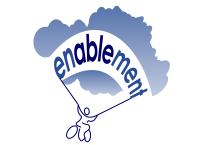Communication and Children with Cerebral Palsy
Top Contributors - Michelle Lee, Naomi O'Reilly, Kim Jackson, Laura Ritchie, Tarina van der Stockt, Admin, Simisola Ajeyalemi, Olajumoke Ogunleye, Evan Thomas and Lauren Lopez
Introduction [edit | edit source]
The information on this page has developed for you from the expert work of Roelie Wolting alongside the Enablement Cerebral Palsy Project and Handicap International Group.
Communication[edit | edit source]
Communication occurs when a sender transmits a message and a receiver understands the message. An effective communicator independently alternates as a sender and a receiver regardless of the demands of a conversation, including settings (e.g., community, school, work, home), conversational partners, and topics. All methods of communication performance are considered in determining the CFCS level. To find out more about the GFCS have a look at this page.
Methods and Challenges of Communication [edit | edit source]
Here are a list of methods of communication and what challenges a child with cerebral palsy may come across:
| Method | Challenge |
|
Speaking |
Coordination of mouth and tongue muscles/ people do not listen to them |
|
Listening |
Concentration |
|
Writing |
Fine motor skills |
|
Showing / pointing at pictures |
Fine motor skills / hand - eye co-ordination |
|
Making gestures / sign language |
Fine motor skills / motor planning |
|
Body language / facial expression |
Muscle control of body / face |









